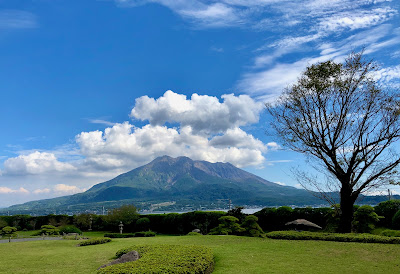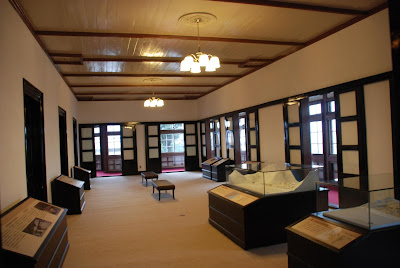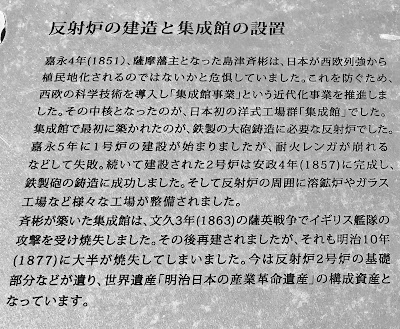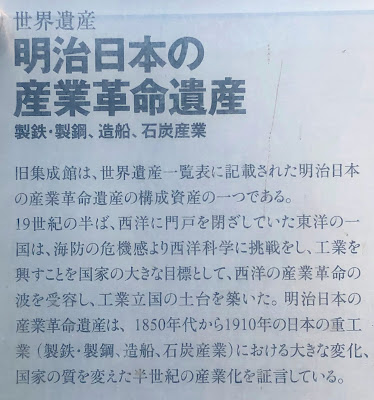目次 / Contents
1) 前回まで / Previously
2) 集成館事業と斉彬 / Shuseikan Industry And Nariaki
A. 集成館事業 / Shuseikan Industry Project
B. 斉彬 / Nariakira
C. 反射炉跡 / The Site of Reverberatory Furnace
2) 9月29日 / 29th of September
A. 尚古集成館 / Shoko Shuseikan Museum
B. 異人館 / Western House
C. アドルフォ・ファルサーリ/ Adolfo Farsari
.jpeg) |
| 仙巌園 鹿児島県鹿児島市吉野町9700-1 私は、姉Yと"仙巌園 (センガンエン)" 、 別名(愛称)、'磯庭園' (イソテイエン) へ行きました。 Sengan-en 9700-1 Yoshinocho, Kagoshima City, Kagoshima Prefecture I and my sister Y visited "Sengan-en"; another name (nickname), Iso-teien : Iso Garden. (Iso means beach in Japanese)  Sakurajima Island From Sengan-en "Sengan-en" is a villa with a beautiful Japanese garden built on the beach by Mitsuhisa Shimazu (1616 - 1695), the 19th head of the Shimazu clan and the 2nd lord of the Satsuma Domain. Official Website : ★ |
This section is mainly about the site of Reverberatory Furnace and Shoko Shuseikan Museum (Former Shuseikan / Former Shuseikan Machinery Factory) .
1) 前回まで / Previously
9月28日に仙巌園観光をした内容は下記です。
御殿前の庭については下記。
御殿ツアーについては下記。
庭の散策については下記。
ブランドショップ・薩摩切子については下記。
Previously
The contents of Sengan-en sightseeing on 28th of September are as follows.
About Gardens in Front of the House, below.
About the House Tour, below.
About Our Walking in the Gardens, below.
See below for the brand shop Satsuma Kiriko.
2) 斉彬による集成館事業
Shuseikan Industry By Nariakira
A. 集成館事業 / Shuseikan Industry Project
薩摩藩11代藩主・島津氏28代当主島津 斉彬 (シマズ ナリアキラ / 1809 - 1858 ) は、ヨーロッパ諸国がアジア各地で植民地化を進めていた事に危機感を持ち、富国強兵 (フコクキョウヘイ) のスローガンのもと、殖産興業 (ショクサンコウギョウ) を始めました。
その1つが、集成館事業 (シュウセイカンジギョウ)でした。
それは、アジアで初めての近代的西洋式工場群で、2015年に
'明治日本の産業革命遺産 製鉄・製鋼、造船、石炭産業' として世界遺産登録されました。
仙巌園の敷地には、集成館事業に含まれていた'反射炉(跡)'と
現在、 '尚古集成館' は、修復により、休館ですは、別館は開いています。
また、すぐ近くに、
(別名 : 異人館 / イジンカン)' があり、
そこも同じく世界遺産登録されています。
私とYは、9月28日に反射炉跡を見て、29日に尚古集成館と旧鹿児島紡績所技師館を外からのみ見学しました。
 |
| 明治日本の産業革命遺産 製鉄・製鋼、造船、石炭産業 Sites of Japan's Meiji Industrial Revolution : Iron and Steel, Shipbuilding and Coal Mining .jpeg) 画像は下記より / These from below ★ |
Shuseikan Industry Project
Nariakira Shimazu (1809 - 1858 / the 11th lord of the Satsuma Domain and the 28th head of the Shimazu Clan) felt a sense of urgency about the colonization of various parts of Asia by European countries, and he adopted the slogan 'Enrich the Country, Strengthen the Armed Forces' and started a policy of 'Encouragement of New Industry'.
One of them was the 'Shuseikan Industry Project'.
It is the first modern Western-style factory group in Asia, and was registered as a World Heritage Site in 2015 as "Sites of Japan's Meiji Industrial Revolution: Iron and Steel, Shipbuilding and Coal Mining".
On the grounds of Sengan-en, there are the 'Reverberatory Furnace (remains)' and 'Shūseikan Machine Factory', which were included in the 'Shuseikan Industry Project', and are registered as World Heritage Sites.
Currently, 'Shoko Shuseikan Museum' is closed due to restoration, but the annex is open.
In addition, there is the 'Former Kagoshima Spinning Engineer's Residence (also known as Ijinkan)' near by, which is also registered within the World Heritage Site.
Ijinkan means Western style residences built mostly for early foreign settlers during the end of the Shogunate and the Meiji era, so the name Ijinkan is used not only here but also other places in Japan.
Y and I saw the Site of Reverberatory Furnace on 28th of September, and on the 29th, we toured the Shoko Shuseikan Museum and the Former Kagoshima Spinning Factory Engineer's Museum, but only from the outside.
 |
| 案内板 / Guide Plate |
B. 斉彬 / Nariakira
父親の10代藩主・島津 斉興 (シマヅ ナリオキ / 1791 - 1859) からも危ぶまれ、藩主の地位を長い間、斉彬に譲ることができませんでした。
斉彬が薩摩藩主になったのは、1851年で、亡くなったのは、1858年藩主であった期間は、たったの7年でした。
それでも後世に、'幕末の名君'と呼ばれ、西郷 隆盛 (サイゴウ タカモリ / 1828 -1877)、大久保 利通 (オオクボ トシミチ / 1830 - 1878) ら幕末に活躍する人材も重用しました。
多くの幕末の偉人達から、彼への褒め言葉が残されています。
斉彬の死因については、病死とされていますが、毒殺説も強く残っています。
 |
| 島津 斉彬 (シマズ ナリアキラ / 1809 - 1858) 斉彬は、薩摩藩11代藩主・島津氏28代当主。 Nariakira Shimazu (1809 - 1858) The 11th lord of the Satsuma Domain and the 28th head of the Shimazu clan. 御殿の説明板より From the explanation board of the House |
Nariakira
Nariakira had an interest in Western studies from an early age, but at that time, such studies were not common, and those around him called him 'ranpeki', meaning that he was Westernized.
His father, the 10th lord of the domain, Narioki Shimazu (1791 - 1859) , was also afraid about Nariakira, and he felt unable to hand over the position of the lord of the domain to his son, Nariakira for a long time.
During the dispute over the succession, there was also a O-Ie Sōdō ; Oyura Sōdō, which was a family dispute.
Nariakira became the lord of Satsuma in 1851, and he died in 1858 after only seven years as lord.
Even so, he was called 'the Wise Ruler, of the End of the Tokugawa Shogunate' in later generations, and also used Takamori Saigō (1828 - 1877) and Toshimichi Ōkubo (1830 - 1878) and others, who were active at the end of the Edo period.
Many great men from the end of the Edo period have left words of praise for him.
Regarding the cause of Nariakira's death, it is said that he died of illness, but there is also a strong theory that he was poisoned.
 |
| 1872年頃の磯地区 集成館事業に関連する建物が多く見えます。 写真 : アドルフォ・ファルサーリ(1841 - 1898) ファルサーリについてはあとで触れます。 The Iso Area Around 1872 Many buildings related to the Shuseikan Industry Project can be seen. Photograph by Adolfo Farsari (1841 - 1898). Farsari will be discussed later. 画像は下記より / This from below ★ |
C. 反射炉跡
The Site of Reverberatory Furnace
1853年に、反射炉は、鉄製大砲の鋳造のため、斉彬によって作られました。
現在、建物はなく、その跡のみを見ることができます。
仙巌園を訪れる前に、私はいくつかの反射炉または反射炉跡を見たことがありました。
私は遺跡を見るのは好きですが、反射炉にもその跡にも興味をあまりもっていませんでした。
なので、ここの反射炉跡に対して、期待をもっていませんでした。
時間制限があったので、見なくてもよいかなとも思っていました。
ですが、ここまで来て、見ないというのも、もったになく思え、とにかく、足を運びました。
当時、斉彬が西洋の国々に侵略されるのを恐れ、反射炉を作ったことには、賛同するものの、私は、反射炉にたいして、ロマンとか、ファンタジーとか、想像力を生み出すものなにかは、感じられません。
'侵略' という危機を感じる時、ロマンとか、ファンタジーとか、言ってられないこともわかります。
幕末、明治維新の際、西洋の武力を知っていた人々の脅威は、平和ボケした私がどれだけ理解できるか疑問ですが。
ほんの少しですが私も海外を経験しました。
そのときに、'日本のあたりまえ' は、よその国には、通じないのだということはしっかり認識しましたので、'ある日の侵略' に対する備えはしなくてはなりません。
そういう気持ちを忘れないためには、反射炉のような遺跡を見るのはよいことでしょう。
昨今、'彼の地での戦争状況' が伝えられ、以前よりは、私を含め、平和ボケの日本人も、危機感をもつようになったかもしれません。
 旧集成館反射炉跡 反射炉下部の遺構。 佐賀藩が有していたオランダの技術書の日本語訳を基にしつつ、 在来工法による石積みや薩摩焼の技術を用いた 耐火煉瓦製造 (タイカレンガセイゾウ)など、 和洋折衷の技術で反射炉が建設されました。 |
 |
 |
The Site of Former Shuseikan Reverberatory Furnace The remains of the lower part of the reverberatory furnace. The reverberatory furnace was constructed using Japanese-Western fusion techniques, such as stone masonry using conventional construction methods and refractory brick manufacturing using Satsuma Ware : Satsuma-yaki technology, based on Japanese translations of Dutch technical manuals owned by the Saga Domain.  |
The Site of Reverberatory Furnace
In 1853, the Reverberatory Furnace was built by Nariakira for casting iron cannons.
There is no building now, only the remains can be seen.
I had seen some reverberatory furnaces or remains of reverberatory furnaces before visiting Sengan-en.
I like to see ruins, but neither the reverberatory furnace nor its ruins interested me much.
So, I didn't have high expectations for the ruins of the reverberatory furnace here.
Since we had limited time, I thought I might not visit it.
However, I thought it would be a waste to come this far and not see it, so I went anyway.
I agree with Nariakira's decision to build a reverberatory furnace out of fear of being invaded by Western countries at that time, however,
I don't feel anything about reverberatory furnaces that creates romance, fantasy, or imagination.
Meanwhile, when I (we) feel the danger of 'invasion', I understand that I (we) can't say romance or fantasy.
At the end of the Tokugawa shogunate and the Meiji Restoration,
I doubt how much I, who am a peace idiot, could understand the threat felt by the people who knew the military power of the West.
Although it was only relatively little, I also have experienced overseas.
At that time, I firmly recognized that 'Japan's common sense' did not apply in other countries, so we have to prepare for 'invasion one day'.
In order not to forget such a feeling, it would be good to see a site like a reverberatory furnace.
Recently, 'the war situation in that distant land' has been reported, and Japanese people who are peace idiots, including myself, may have come to have a sense of crisis.
反射炉跡の近くには、'反射炉の仕組みをCGで解説した映像展示'が見られる、オリエンテーション・センター : ★があります。
ですが、私達は、時間制限があり、ここは素通りしました。
 |
オリエンテーション・センター : ★ '薩摩からはじまった日本の近代化ストーリー' が わかりやすく説明されています。 Orientation Centre 'The story of Japan's modernization that started with Satsuma' is explained in an easy-to-understand manner. |
Near the Site of Reverberatory Furnace, there is an Orientation Centre where you can see a 'video exhibition explaining the mechanism of a reverberatory furnace using CG'.
However, we had limited time and skipped this one.
2) 9月29日 / 29th of September
A. 尚古集成館 / Shoko Shuseikan Museum
尚古集成館が修復工事のため、中へは入れないことも知っていましたが、建物だけでも、撮影したいと思いました。
尚古集成館は、'仙巌園入り口' から道路を挟んだ向かいにあります。
ですが、そのことを訪れた際に、知らずに、尚古集成館の建物を仙巌園 の入り口から入って探しました。
そうなった他の理由に、私からの質問に対するタクシーの運転手さんの答えにもあります。
私がタクシーの運転手さんに、世界遺産登録の場所を聞いた時に、
彼は、
「ここすべてです」
と答えました。
なので、私は、入り口から先に、尚古集成館があると信じ、尚古集成館を探し続けることになりました。
(地図を注意深く見れば、建物が外にあることに気がついたでしょうけれど...)
一口を出る際に、係の人にその場所を聞いて、尚古集成館は入り口の外であることを知ったのです。
またその運転手さんは、すぐちかくに’、世界遺産登録された "旧鹿児島紡績所技師館 (異人館)" があることをも教えてくれませんでした (もしくは知らなかったのかもしれません)。
この日 (28日) の運転手さんは、こういったことはよくご存知ないようでした。
(ですが、由来は教わりませんでしたが、猫神社の存在は、この運転手さんから教わりました。ありがとうございました。)
そのうえ、事前に知らせていた訪問地へかなり長い間迷って到着し、それがその後の計画を狂わせて、予約時間をオーバーする事態を招いたにもかかわらず、私達は彼に追加料金を払いました。(他にオーバーする理由もあったので払いましたが、それも彼が迷わず到着してくれれば、防げたことでした)
ですが、ラッキーなことに、翌日 (29日) の運転手のSさんは、さまざまな知識があり、最初の予定にはなかった、尚古集成館や異人館にも寄ってくださり、撮影時間を設けてくださりました。
また、彼は、他にも予定外の訪問地がいくつかあったにもかかわらず、効率よく、迷うことなく的確に訪問地に私達を案内してくださり、追加料金を請求される事態にもなりませんでした。
本当に、Sさんには感謝しています。
ありがとうございました。
Shoko Shuseikan Museum
I knew that Shoko Shuseikan Museum is under renovation, so we couldn't go inside, but I wanted to take a picture of the building itself.
Shoko Shuseikan Museum is separate, located across the road from the 'Sengan-en entrance'.
However, when we visited there, we didn't know about that, so I was looking for the building of Shoko Shuseikan Museum after we went through the entrance.
The reason for making that situation was the taxi driver's answer to my question,
"Where is the World Heritage site?"
he said,
"Everything is here."
so, I believed that the Shoko Shuseikan Museum was beyond the entrance, so I continued looking for it.
(If I had looked carefully at the map, I should have noticed that the building is outside...)
When we were about to leave, I asked the staff
"Where is the Museum?"
and we found out that the Museum is outside the entrance.
Also, the driver didn't tell us that there is 'the Former Kagoshima Spinning Factory Engineer's House (Ijinkan)', which was registered as the World Heritage Site, nearby (or maybe he doesn't know about it).
The driver on this day (28th) didn't seem to know much about these.
( I didn't learn about the origin, but I was told about the existence of the Cat Shrine by this driver. Thank you.)
In addition, he was lost for quite some time arriving at the previously planned destination that disrupted the subsequent plan and caused a situation where the reserved time was exceeded and then we paid him an extra fee.
(There were other reasons for overpayment, so we paid, but it could have been avoided if he had not got lost.)
However, luckily, a driver, S San for the next day (29th) has a lot of knowledge and even stopped by Shoko Shuseikan Museum and Ijinkan, which weren't originally planned, and gave us time to take pictures.
In addition, even though he drove us to visit several other unscheduled places, he guided us to the places efficiently and accurately without hesitation, and he didn't even charge any additional fee.
We really appreciate S San.
Thank you very much.
 |
| 尚古集成館 仙巌園を訪れた翌日、29日に撮影しました。 Shoko Shusei Museum This photograph was taken on the 29th, the day after we visited Sengan-en. |
.jpeg) |
| 入り口 閉まっている入り口を撮ることは躊躇しましたが 尚古集成館の扁額 (ヘンガク) が立派だったので、撮影しました。 Entrance I was hesitant to take a picture of the closed entrance, but I took it because the plaque of Shoko Shuseikan Museum was fine. |
 |
尚古集成館・別館 左に、運転手のSさんと姉のY。 二人は、撮影している私を待ってくれています。 ありがとうございます! Shoko Shuseikan Museum・the Annex On the left, the driver S San and my sister Y are, waiting for me while I am filming. Thank you! |
B. 異人館 / Western House
仙巌園訪問の翌日29日、私達は前日と違うタクシー会社、違う運転手、Sさんの案内で、鹿児島市内から、観光をしつつ、霧島温泉郷
(キリシマオンセンキョウ) へ向かいました。
城山 (シロヤマ)からの景色を見た跡、尚古集成館と旧鹿児島紡績所技師館 (異人館)にゆきました。
(城山については次のセクションに載せます)
撮影だけが目的で、尚古集成館へ寄った際に、Sさんから
「紡績所に招かれた英国人技師の住居であった洋館があって、異人館と呼ばれている」
と聞き、興味がわきました。
私の夫Rは、英国人なので、その洋館を見るだけ見てみようという気持ちになりました。
異人館への入館は可能でしたが、今日、予定していたコースにはなかったので、外からの見学と撮影だけしました。
 |
| 旧鹿児島紡績所跡の碑 1867年、鹿児島紡績所は、 薩摩藩・最後の藩主(12代)、島津氏29代当主、 建設されました。 そのときに、英国より7名の技術者を招いて工場の設計と 技術指導を依頼しました。 1897年に閉鎖されました。 ちなみに1867年は、大政奉還 (タイセイホウカン) の年です。 Monuments of 'The Site of Kagoshima Spinning Mill' In 1867, Kagoshima Spinning Mill was established by Tadayoshi Shimazu (1840 - 1897), the last lord of the Satsuma Domain (12th) and the 29th head of the Shimazu Clan. At that time, he invited seven engineers from England to design the factory and provide technical guidance. It was closed in 1897. By the way, 1867 is the year of Taisei Hokan :  鹿児島紡績所 Kagoshima Spinning Mill  機械配置図 尚古集成館所蔵 Layout of Spinning Machines Collection by Shoko Shuseikan Museum   |
Western House
On the 29th, the day after our visit to Sengan-en, we headed to Kirishima Hot Springs Village from Kagoshima City while sightseeing, guided by a different taxi company and a different driver, S San.
After seeing the scenery from Mount Shiroyama, we went to the Shoko Shuseikan and the Former Kagoshima Spinning Factory Engineer's House (Ijinkan).
(Shiroyama will be posted in the next section)
When we stopped by Shoko Shuseikan Museum just for the purpose of taking pictures, we heard from S San that
"There is a Western-style building called Ijinkan, which was the residence of British engineers who were invited to work at the spinning mill".
My husband, R, is British, so I felt I would try just looking at that Western-style building.
It was possible for us to enter the Ijinkan, but it wasn't in the route we planned for today, so we only observed and I photographed it from the outside.
 |
| 旧鹿児島紡績所技師館 国の重要文化財および世界文化遺産。 旧鹿児島紡績所技師館は、招かれた英国人技術者の 住居として建設された洋館です。 外見は、洋館であるものの、柱には尺寸法が用いられ、 小屋組 (コグミ) が和式であるなど、和洋折衷です。 Former Kagoshima Spinning Engineer's Residence Japanese National Important Cultural Property and the World Heritage Site. Former Kagoshima Spinning Factory Engineer's House is a Western-style building that was built as a residence for invited British engineers. Although it looks like a Western-style building from the outside, it is a mixture of Japanese and Western styles, with shaku dimensions (Japanese measure) used for the pillars and the roof trusses is Japanese-style.  |
英国人技術者帰国後は、大砲製造の支配所などに使用されました。
1882年に鹿児島城本丸跡に移築され学校などに使用された後、
1936年に再び現在の場所に移築されました。
'異人館'として公開されています。
After the British engineers returned, it was used as a cannon manufacturing centre.
In 1882, it was relocated to the ruins of Kagoshima Castle and used as a school, etc., and was relocated to its current location in 1936.
It is open to the public as "Ijinkan".
 |
| 別名・'異人館' '異人館'という通称は、主に幕末から明治時代にかけて、 初期の外国人入植者のために建てられた 西洋式の邸宅を意味します。 なので、日本各地にあります。 私は神戸に住んでいたので、私にとって、 異人館といえば、'風見鶏の館' : ★です。 Also Known As 'Ijinkan' The popular name 'Ijinkan' refers to Western-style mansions built mainly for early foreign settlers from the end of the Edo period to the Meiji period. So they are all over Japan. I used to live in Kobe, so for me, Ijinkan means |
屋内の下の写真は、他のサイトからお借りしています。
ありがとうございます。
The photographs below are borrowed from other sites.
Thank you very much.
 |
| 画像は下記より / This from below ★ |
旅行の計画を立てている時に、異人館を知っていたなら、屋内見学の時間をとっていたと思います。
見ることができず、とても残念でした。
それでも、まったく知らずにいたよりは、立ち寄って建物を見ることができたのは、ラッキーでした。
 |
| 画像は下記より / This from below ★ |
 |
| 画像は下記より / This from below ★ |
If I had known of this Ijinkan when I was planning our trip, I would have made the time to tour the interior.
We couldn't see it, and it was very disappointing.
Still, we were lucky enough to stop by and see the building rather than completely ignoring it.
 |
| 画像は下記より / This from below ★ |
 |
| 画像は下記より / This from below ★ |
C. アドルフォ・ファルサーリ
Adolfo Farsari
イタリア人の写真家、アドルフォ・ファルサーリを初めて知りました。
彼はイタリア人ですが、1863年にアメリカへ移住しました。
1873年に来日し、横浜を活動拠点としました。
彼の写真の特徴は、彩色写真です。
しばしば、彼の写真または作風は、"横浜写真"と呼ばれました。
彼は1890年に日本女性の間にできた娘とともにイタリアへ渡り、1898年に彼は故郷のヴィチェンツァで亡くなりました。
ファルサーリが日本を離れてからも、ファルサーリを名目上の経営者として横浜のスタジオは存続しました。
1901年以降は数人の日本人が経営者となり、1917年まではスタジオとして機能していましたが、1923年の関東大震災の被災により、スタジオは閉鎖されました。
下記、Wikiから引用。
"現在ファルサーリの写真とアルバムは多くの美術館、個人コレク
ションに所蔵されている。
2004年にはボストン美術館で彼の作品の特別展が開催された"
 |
| 1872年頃の磯地区 鹿児島県鹿児島市吉野町の風景 写真 : アドルフォ・ファルサーリ(1841 - 1898) The Iso Area Around 1872 Painted photograph from Japan, dating from before 1886, according to a written note on the album containing the photographs. Presumed Author of the original photographs : Adolfo Farsari (1841 - 1898). 画像は下記より / This from below ★ |
Adolfo Farsari
I found out that an Italian photographer, Adolfo Farsari came to Japan in 1873 and made Yokohama his base of operations.
His photography features colour photography.
His photography or style was often called "Yokohama Photography"
When I found that his famous motif was the Great Buddha : Dai Butsu statue of Kotoku-in Temple in Kamakura, I was surprised to feel a connection with myself.
In 1890, he went to Italy with his daughter who he had had by a Japanese woman, and died in his hometown of Vicenza in 1898.
According to Wiki about him,
"Farsari's photographs and albums are included in numerous museums and private collections around the world, and a selection of his works was exhibited at the Museum of Fine Arts, Boston in 2004."
 |
| 鎌倉高徳院の大仏 手彩色写真 / 1885 - 1890 写真 : アドルフォ・ファルサリ Dai Butsu in Kōtoku-in Temple, Kamakura Hand-coloured albumen silver print by Adolfo Farsari, between 1885 and 1890. 画像は下記より / This from below ★ |
次のセクションは28日の夕食についてで、それ以降、数回分のブログは、29日の観光についてです。
The next section will be about our dinner on the 28th, and the next few sections will be about sightseeing on the 29th.


.jpeg)





.jpeg)
.jpeg)




.jpeg)
.jpeg)



.jpeg)

.jpeg)
0 件のコメント:
コメントを投稿